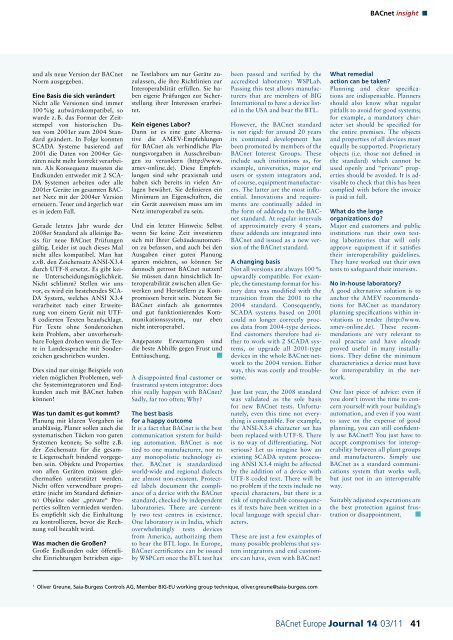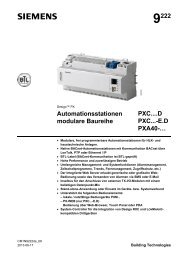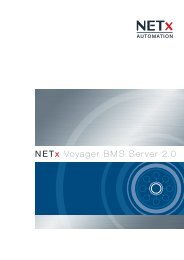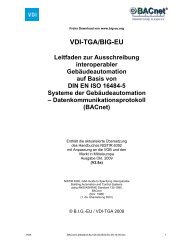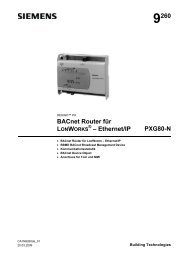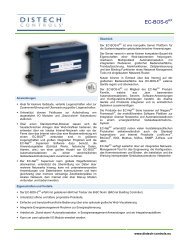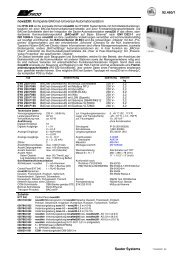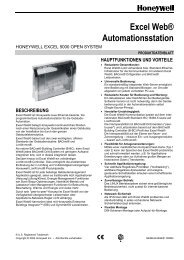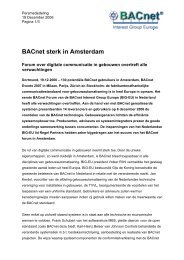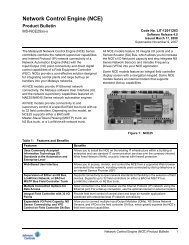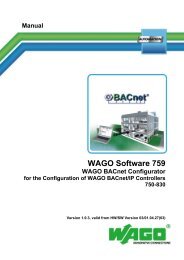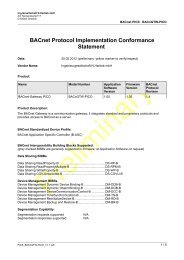Journal - BACnet Interest Group Europe eV
Journal - BACnet Interest Group Europe eV
Journal - BACnet Interest Group Europe eV
Erfolgreiche ePaper selbst erstellen
Machen Sie aus Ihren PDF Publikationen ein blätterbares Flipbook mit unserer einzigartigen Google optimierten e-Paper Software.
und als neue Version der <strong>BACnet</strong><br />
Norm ausgegeben.<br />
Eine Basis die sich verändert<br />
Nicht alle Versionen sind immer<br />
100 %ig aufwärtskompatibel, so<br />
wurde z. B. das Format der Zeitstempel<br />
von historischen Daten<br />
vom 2001er zum 2004 Standard<br />
geändert. In Folge konnten<br />
SCADA Systeme basierend auf<br />
2001 die Daten von 2004er Geräten<br />
nicht mehr korrekt verarbeiten.<br />
Als Konsequenz mussten die<br />
Endkunden entweder mit 2 SCA-<br />
DA Systemen arbeiten oder alle<br />
2001er Geräte im gesamten <strong>BACnet</strong><br />
Netz mit der 2004er Version<br />
erneuern. Teuer und ärgerlich war<br />
es in jedem Fall.<br />
Gerade letztes Jahr wurde der<br />
2008er Standard als alleinige Basis<br />
für neue <strong>BACnet</strong> Prüfungen<br />
gültig. Leider ist auch dieses Mal<br />
nicht alles kompatibel. Man hat<br />
z.vB. den Zeichensatz ANSI-X3.4<br />
durch UTF-8 ersetzt. Es gibt keine<br />
Unterscheidungsmöglichkeit.<br />
Nicht schlimm? Stellen wir uns<br />
vor, es wird ein bestehendes SCA-<br />
DA System, welches ANSI X3.4<br />
verarbeitet nach einer Erweiterung<br />
von einem Gerät mit UTF-<br />
8 codierten Texten beaufschlagt.<br />
Für Texte ohne Sonderzeichen<br />
kein Problem, aber unvorhersehbare<br />
Folgen drohen wenn die Texte<br />
in Landessprache mit Sonderzeichen<br />
geschrieben wurden.<br />
Dies sind nur einige Beispiele von<br />
vielen möglichen Problemen, welche<br />
Systemintegratoren und Endkunden<br />
auch mit <strong>BACnet</strong> haben<br />
können!<br />
Was tun damit es gut kommt?<br />
Planung mit klaren Vorgaben ist<br />
unablässig. Planer sollen auch die<br />
systematischen Tücken von guten<br />
Systemen kennen; So sollte z.B.<br />
der Zeichensatz für die gesamte<br />
Liegenschaft bindend vorgegeben<br />
sein. Objekte und Properties<br />
von allen Geräten müssen gleichermaßen<br />
unterstützt werden.<br />
Nicht offen verwendbare proprietäre<br />
(nicht im Standard definierte)<br />
Objekte oder „private“ Properties<br />
sollten vermieden werden.<br />
Es empfiehlt sich die Einhaltung<br />
zu kontrollieren, bevor die Rechnung<br />
voll bezahlt wird.<br />
Was machen die Großen?<br />
Große Endkunden oder öffentliche<br />
Einrichtungen betrieben eige-<br />
ne Testlabors um nur Geräte zuzulassen,<br />
die ihre Richtlinien zur<br />
Interoperabilität erfüllen. Sie haben<br />
eigene Prüfungen zur Sicherstellung<br />
ihrer Interessen erarbeitet.<br />
Kein eigenes Labor?<br />
Dann ist es eine gute Alternative<br />
die AMEV-Empfehlungen<br />
für <strong>BACnet</strong> als verbindliche Planungsvorgaben<br />
in Ausschreibungen<br />
zu verankern (http://www.<br />
amev-online.de). Diese Empfehlungen<br />
sind sehr praxisnah und<br />
haben sich bereits in vielen Anlagen<br />
bewährt. Sie definieren ein<br />
Minimum an Eigenschaften, die<br />
ein Gerät ausweisen muss um im<br />
Netz interoperabel zu sein.<br />
Und ein letzter Hinweis: Selbst<br />
wenn Sie keine Zeit investieren<br />
sich mit Ihrer Gebäudeautomation<br />
zu befassen, und auch bei den<br />
Ausgaben einer guten Planung<br />
sparen möchten, so können Sie<br />
dennoch getrost <strong>BACnet</strong> nutzen!<br />
Sie müssen dann hinsichtlich Interoperabilität<br />
zwischen allen Gewerken<br />
und Herstellern zu Kompromissen<br />
bereit sein. Nutzen Sie<br />
<strong>BACnet</strong> einfach als genormtes<br />
und gut funktionierendes Kommunikationssystem,<br />
nur eben<br />
nicht interoperabel.<br />
Angepasste Erwartungen sind<br />
die beste Abhilfe gegen Frust und<br />
Enttäuschung.<br />
A disappointed final customer or<br />
frustrated system integrator: does<br />
this really happen with <strong>BACnet</strong>?<br />
Sadly, far too often; Why?<br />
The best basis<br />
for a happy outcome<br />
It is a fact that <strong>BACnet</strong> is the best<br />
communication system for building<br />
automation. <strong>BACnet</strong> is not<br />
tied to one manufacturer, nor to<br />
any monopolistic technology either.<br />
<strong>BACnet</strong> is standardized<br />
world-wide and regional dialects<br />
are almost non-existent. Protected<br />
labels document the compliance<br />
of a device with the <strong>BACnet</strong><br />
standard, checked by independent<br />
laboratories. There are currently<br />
two test centres in existence.<br />
One laboratory is in India, which<br />
overwhelmingly tests devices<br />
from America, authorizing them<br />
to bear the BTL logo. In <strong>Europe</strong>,<br />
<strong>BACnet</strong> certificates can be issued<br />
by WSPCert once the BTL test has<br />
been passed and verified by the<br />
accredited laboratory: WSPLab.<br />
Passing this test allows manufacturers<br />
that are members of BIG<br />
International to have a device listed<br />
in the USA and bear the BTL.<br />
However, the <strong>BACnet</strong> standard<br />
is not rigid: for around 20 years<br />
its continued development has<br />
been promoted by members of the<br />
<strong>BACnet</strong> <strong>Interest</strong> <strong>Group</strong>s. These<br />
include such institutions as, for<br />
example, universities, major end<br />
users or system integrators and,<br />
of course, equipment manufacturers.<br />
The latter are the most influential.<br />
Innovations and requirements<br />
are continually added in<br />
the form of addenda to the <strong>BACnet</strong><br />
standard. At regular intervals<br />
of approximately every 4 years,<br />
these addenda are integrated into<br />
<strong>BACnet</strong> and issued as a new version<br />
of the <strong>BACnet</strong> standard.<br />
A changing basis<br />
Not all versions are always 100 %<br />
upwardly compatible. For example,<br />
the timestamp format for history<br />
data was modified with the<br />
transition from the 2001 to the<br />
2004 standard. Consequently,<br />
SCADA systems based on 2001<br />
could no longer correctly process<br />
data from 2004-type devices.<br />
End customers therefore had either<br />
to work with 2 SCADA systems,<br />
or upgrade all 2001-type<br />
devices in the whole <strong>BACnet</strong> network<br />
to the 2004 version. Either<br />
way, this was costly and troublesome.<br />
Just last year, the 2008 standard<br />
was validated as the sole basis<br />
for new <strong>BACnet</strong> tests. Unfortunately,<br />
even this time not everything<br />
is compatible. For example,<br />
the ANSI-X3.4 character set has<br />
been replaced with UTF-8. There<br />
is no way of differentiating. Not<br />
serious? Let us imagine how an<br />
existing SCADA system processing<br />
ANSI X3.4 might be affected<br />
by the addition of a device with<br />
UTF-8 coded text. There will be<br />
no problem if the texts include no<br />
special characters, but there is a<br />
risk of unpredictable consequences<br />
if texts have been written in a<br />
local language with special characters.<br />
These are just a few examples of<br />
many possible problems that system<br />
integrators and end customers<br />
can have, even with <strong>BACnet</strong>!<br />
1 Oliver Greune, Saia-Burgess Controls AG, Member BIG-EU working group technique, oliver.greune@saia-burgess.com<br />
<strong>BACnet</strong> insight<br />
What remedial<br />
action can be taken?<br />
Planning and clear specifications<br />
are indispensable. Planners<br />
should also know what regular<br />
pitfalls to avoid for good systems;<br />
for example, a mandatory character<br />
set should be specified for<br />
the entire premises. The objects<br />
and properties of all devices must<br />
equally be supported. Proprietary<br />
objects (i.e. those not defined in<br />
the standard) which cannot be<br />
used openly and “private” properties<br />
should be avoided. It is advisable<br />
to check that this has been<br />
complied with before the invoice<br />
is paid in full.<br />
What do the large<br />
organizations do?<br />
Major end customers and public<br />
institutions run their own testing<br />
laboratories that will only<br />
approve equipment if it satisfies<br />
their interoperability guidelines.<br />
They have worked out their own<br />
tests to safeguard their interests.<br />
No in-house laboratory?<br />
A good alternative solution is to<br />
anchor the AMEV recommendations<br />
for <strong>BACnet</strong> as mandatory<br />
planning specifications within invitations<br />
to tender (http://www.<br />
amev-online.de). These recommendations<br />
are very relevant to<br />
real practice and have already<br />
proved useful in many installations.<br />
They define the minimum<br />
characteristics a device must have<br />
for interoperability in the network.<br />
One last piece of advice: even if<br />
you dont’t invest the time to concern<br />
yourself with your building’s<br />
automation, and even if you want<br />
to save on the expense of good<br />
planning, you can still confidently<br />
use <strong>BACnet</strong>!! You just have to<br />
accept compromises for interoperability<br />
between all plant groups<br />
and manufacturers. Simply use<br />
<strong>BACnet</strong> as a standard communications<br />
system that works well,<br />
but just not in an interoperable<br />
way.<br />
Suitably adjusted expectations are<br />
the best protection against frustration<br />
or disappointment.<br />
<strong>BACnet</strong> <strong>Europe</strong> <strong>Journal</strong> 14 03/11 41


